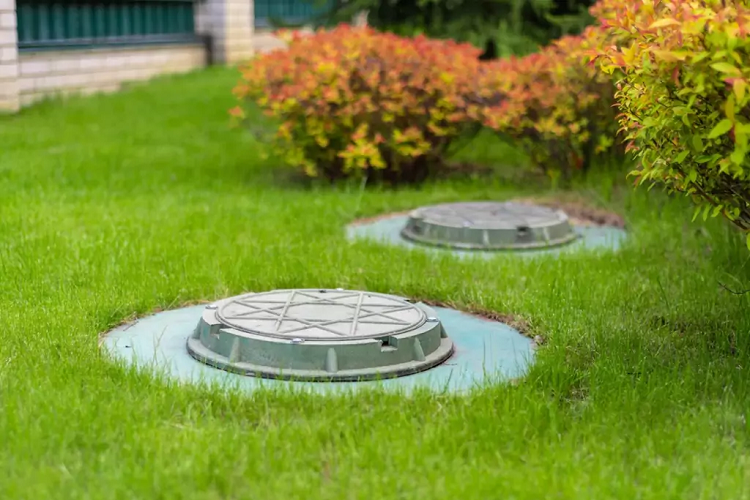Do you have a septic tank in your home that shows different problems continuously, and gives you warning signs? But still, you are ignoring those signs. Your home’s septic tank is the main component of your home. The septic tank manages the wastewater in your homes and other places.
If the septic tank shows problems it might be very difficult to handle it. But if you adopt the different septic tank problems and solutions it would be very easy for you to handle these issues on time.
Here, we discuss the common septic tank problems that need to require maintenance as soon as possible.

Understanding Septic Tanks Different Types
There are different types of septic tanks. Each type is used for different purposes. The types of septic tanks include.
- Cluster system
- Chamber septic system
- Gravity system
- Conventional system
- Drip distribution system
- Recirculating sand filter system
12 Common Septic Tank Problems
Here are some of the common septic tank problems that show system failure.
1. Bad Smell
The first sign that your septic tank shows that requires maintenance is the bad smell coming from your main drainage field. The bad smell is due to the clogged or blocked main drainage pipes and it requires pumping. If the solid particles in the septic tank are stuck it causes a pungent smell. The septic tank smell is very dangerous and toxic and can lead to many serious diseases.
How to fix it:
A bad smell in the septic tank is hazardous and causes many diseases. So it is best to treat it as early as possible.
- The first solution that treats the septic tank smell is regular maintenance. Regular maintenance and pumping removes the accumulated solids that are stuck inside the septic tank and reduces the bad fragrance.
- Another way to eliminate the tank’s bad smell is to use safe cleaning chemicals in the toilets, sinks, and shower rooms. The harsh chemicals damage the bacteria in the septic tank and generate odor.
- Baking soda also works well to reduce the septic tank smell. Baking soda contains unique properties that prevent unpleasant smells and also improve the performance of the septic tank.
2. Leaking Tanks
The leaking is another common problem that requires maintenance. If your pipe is corroded over time or is poorly installed then this is the reason for the leaking in the septic system.
How to fix it:
- The solution to fix the leaking septic tank water is to reduce the water use.
- Another solution is to inspect and regularly maintain the septic tank. The regular inspection helps to prevent further damage.
3. Standing Water
Another common sign that the septic tank shows is the standing water. The standing water near the septic tank may be due to the clogged or blocked drainage system and heavy rainfall. The other reason for standing water is that the septic tank is not given any proper maintenance.
How to fix it:
- The only way to properly care for septic tank standing water is to contact a professional.
- However, if the standing water near the septic tank is caused by significant rainfall, the only solution is to allow it to remain until the water is completely absorbed by the earth.
4. High Energy Bills
Another common problem that people mostly ignore is the higher energy bills than usual. The high energy bills are due to the water leakage and the water in the toilets is not fully disposed of and instead continuously leaks out in the drain field. This is the reason for high energy bills and the water meter runs faster than usual.
How to fix it:
If there is a significant increase in the energy bills follow these steps.
- The only solution that fixes the high energy bills is to replace the septic tank with a new one.
- Another solution to fix the high energy bills is to contact septic tank inspection services.
5. Ground Movement
Another problem that your septic tank shows is the ground movement. The septic tank system is installed under the ground. The movement of the ground can cause pressure near the septic tank which even causes cracks and fractures near the walls of the septic tank. If the ground movement arises it can cause very serious issues in the septic tank.
How to fix it:
The ground movement can cause different problems if not treated on time. The ground movement can ultimately damage the structure of the building.
- The solution to fix the ground movement is to maintain your septic tank and dispose of the tank regularly.
- Another way to fix that issue is, if you want to ensure that your septic tank operates effectively and is not damaged, you can replace the septic tank.
6. A Collapsed Baffle
Another common septic tank issue is a collapse baffle. The collapsed baffle can occur when solid particles are flushed down the toilet, or if the pipe is improperly installed.
How to fix it:
- To fix the collapsed baffle, first inspect it to figure out the extent of the damage. Evaluate the damage, whether it is a partial or complete collapse.
- The collapsed baffle cannot be repaired. So the only way to repair this is to replace it with a new baffle.
7. Slows Drains
Slow drains can indicate a septic tank problem and this is the major issue. Slow drains are causing trouble and need to be addressed on time. The slow drains in the septic tank are due to the blockage of the main drain pipe.
How to fix it:
Slow drains in the septic tank cause trouble.
- To fix the slow drains issue, pour hot water several times in the septic tank.
- If your septic tank clog is blocked insert the plunger or drain snake in the drainage system to remove the obstruction.
8. Improper Maintenance
Another common cause of septic tank failure is the lack of maintenance. Improper septic tank maintenance can cause extreme damage and result in many problems which include clogged drains, breakdown in the main pipeline, and reduced septic tank performance.
How to fix it:
- Regular maintenance is important to solve this problem. It is the best option to inspect the septic tank at least once a year or whenever needed, to avoid any septic tank system failure.
- If you do not know the right way to take care of the septic system you could contact the professional service septic tank provider.
9. Tree Roots
Another very common septic tank issue that requires maintenance is the tree roots infiltrating your pipes. Most of the septic tanks are installed near the trees and shrubs. This can cause issues and the tree roots have been growing through the tank cracks. The tree roots can ultimately damage the septic tank and even tree roots can block the inlet pipes.
How to fix it:
- The simple cutting is not the solution to kill the tree roots, as the tree roots are coming back again. Different chemicals are made to kill the tree root’s growth and one of the chemicals is the copper sulfate septic treatment method. This method will act as a poison barrier within the soil and thus kill the growth of tree roots.
10. Blooms of Algae in the Nearby Water
The most common problem with septic tanks is the algae growth. The growth of algae growth is very dangerous. The biggest problem that contributes to the growth of algae is the failure of the septic tank. The high level of nitrates is the major cause of algae growth.
How to fix it:
- The only solution to reduce the algae bloom is to use phosphorus-free fertilizer and nutrients.
- Another way to get rid of algae is to dispose of household water properly.
- The best solution is to reduce the amount of fertilizers near the pond.
11. Improper Installation
The improper installation leads to many issues in the septic tank including health hazards and environmental damage. The improper installation leads to many problems which include poor drainage of waste water in the septic tank and soggy soil. Another common reason for septic tank failure is that your septic tank fills too quickly.
How to fix it:
- The only solution that fixes this issue is that if you want to install the septic tank always consider the professionals for this purpose.
12. Hydrostatic Pressure
Another common septic tank issue is hydrostatic pressure. This issue is rare but sometimes it can happen. This problem arises when the volume of the water beneath the ground is high and it causes pressure on the septic tank.
How to fix it:
- The solution to fix that problem is to remove the water and install the drainage system.
Causes of Septic Tank Failure
-
Increased in the Use of Water
The most common reason for septic tank failure is an increase in the use of water. The water will go into the septic tank if you use more water in your home, and too much water will enter into the drain field, and thus block the main pipelines.
-
Use of Biomaterials
The major cause of septic tank failure is the use of biomaterials. The biomaterials consist of different types of bacteria in the septic drain field. The biomaterials break down the organic waste.
A healthy level of biomaterials is essential for the septic tank to work properly. You introduce a new level of bacteria when you flush the toilet. When you pump the septic tank it will take one to three weeks for the system to attain the proper bacteria level
-
Use of Detergents
The most common cause of septic tank failure is the use of cleaning agents. Cleaning products include hazardous substances that can contaminate the septic tank. These components obstruct the drain field when they enter the septic tank.
When Does a Septic Tank Need Pumping?
Many factors determine how often a septic tank needs to be pumped.
- Type of septic tank
- Size of your septic tank
- Your water usage
- Size of the household
However, the septic tank is pumped at least once a year. If you don’t pump the septic tank on time the sludge and scum will accumulate in the septic tank and cause different problems.
Cost of Septic Tank
The cost of septic tanks depends on various factors which include.
- Size of the tank
- Material of the tank
- Labor and installation cost
- Permit and inspection fees
The average cost to install the septic tank also depends on the location. However, the average cost of a septic tank is around $1000-$4000.
Septic Tank Do and Dos
The following are the DO and DOS of the septic tank.
Do:
- To avoid overloading the septic tank use conserve water.
- Inspect your septic tank regularly to avoid any further damage.
- Cover the drain field with the grass cover to prevent corrosion and remove the excess water.
- For washing and cleaning purposes use the natural cleaners in the septic tank to prevent any damage.
Dos:
- The materials that will not easily be decomposed such as hair, oil, fats, or feminine hygiene products don’t flush these products directly.
- The medicines or any other hazardous products contain materials that don’t directly decompose so don’t flush that products.
- Don’t grow any plant near the drain field except grass.
- The septic system requires a regular power supply so don’t off the power supply.
- Cover the drain field with a soft surface, don’t cover it with a hard surface.
Conclusion
Regular maintenance of the septic tank is crucial because the septic tank is an important component of the home that never be ignored. Taking care of the septic tank will extend the lifespan of the septic system and prevent you from costly repairs.
Some signs show your septic tank needs maintenance, including bad smell, leaking tanks, high energy bills, slow drains, lack of maintenance, and blooms of algae in the nearby water.
Inspect and maintain the septic tank at least once a year. If you notice any of these problems it is best to contact the septic tank inspection team as early as possible to avoid any further damage.


